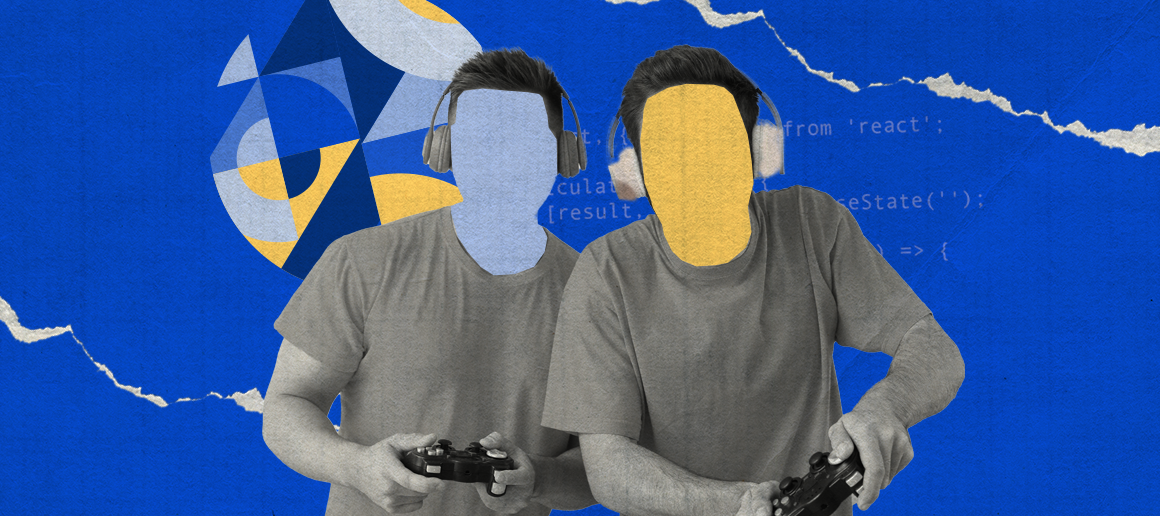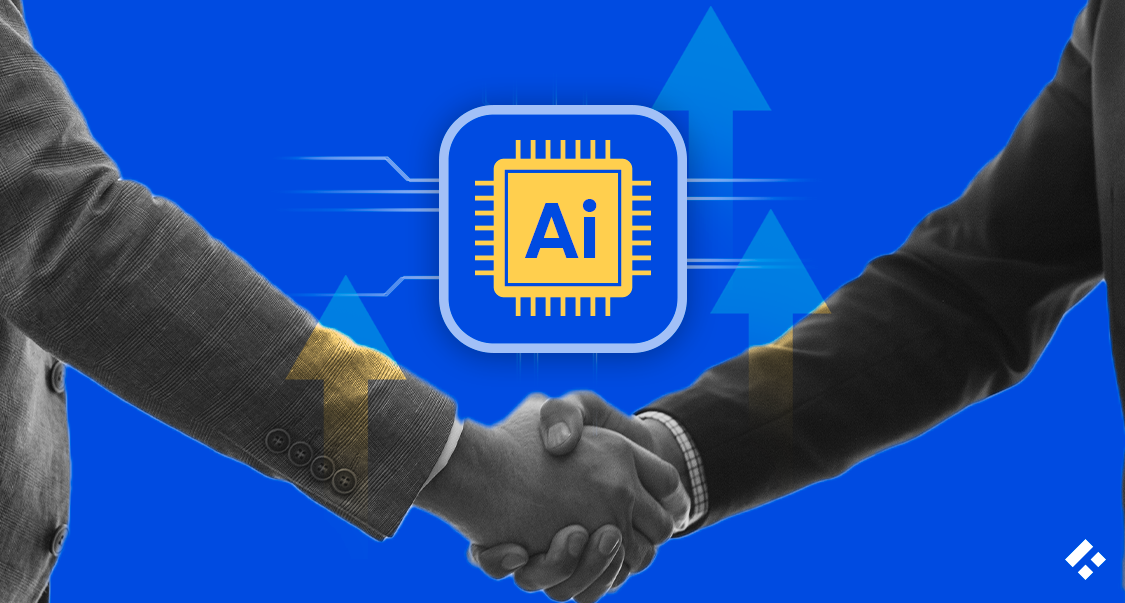Remember that time when your mom told you to stop playing computer games and do something useful? She would probably be surprised to learn that today, some of the most successful businesses rely on gaming principles to boost customer loyalty, employee engagement, and even recruitment.
Various companies are leveraging gaming technologies by integrating them into new industries whose purposes extend far beyond entertainment. At this point, the only limit to gamification is the human imagination.
The term “gamification” emerged in 2002, thanks to Nick Pelling, but gained significant recognition in 2010, when the rise of social networking led to the widespread incorporation of gaming elements into networking software. Since then, the variety of applications has grown drastically.
Examples of gamification can be quite diverse. Some gamification examples include:
- Health & Wellness
- Education
- Food & Beverage
- Transportation
- Retail
- Banking
The global value of the gamification market was $6.8 billion back in 2018. In 2025, the total value is an incredible $29.11 billion. Now that you know that gamification is a booming market, how exactly can you use it for your business? You’ll find out here.
If you need front-end developers and UI/UX specialists who can help you implement these techniques, you are in the right place. Our experienced developers from regions like LATAM can help you in the most cost-effective way possible.
Are you ready to start your development project?
We have the developers you need to take your development project in the right direction.
Companies are proven to grow their business faster with Trio.
What Is Gamification?
Gamification is the process of incorporating game elements and mechanics into a digital environment to enhance engagement and user experience. In simpler words, it’s the use of game elements in a non-gaming environment.
It is often confused with creating games for business purposes, which it is not. Gamification is much more than just fun and engagement. It’s a data-driven way to tap into human psychology and motivation.
Research in behavioral science shows that people are more engaged when they receive immediate feedback, see visible progress, and experience recognition. This is why gamification works.
For example, according to Buell, Cai, and Sandino, companies that use gamification in employee training can improve performance by up to 40%. This demonstrates that gamification is not merely a trend.
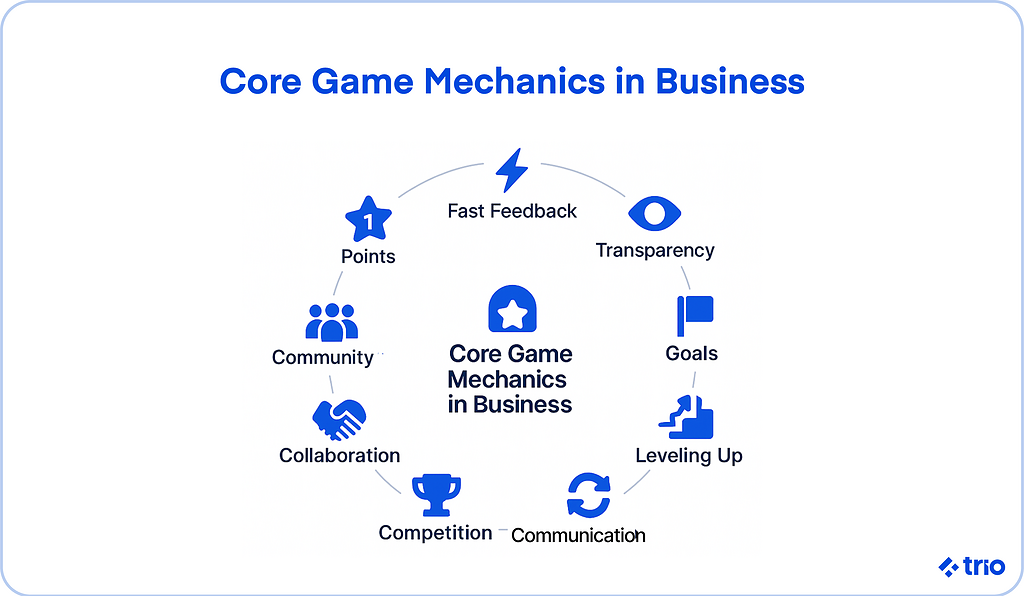
The ten game mechanics that are commonly used for these purposes are:
- Fast Feedback
- Transparency
- Goals
- Badges
- Leveling Up
- Onboarding
- Competition
- Collaboration
- Community
- Points
These mechanics may not seem revolutionary on their own, but together they trigger psychological drivers such as achievement, belonging, and mastery. When used correctly, they can directly contribute to business growth.
Take Autodesk as an example. By introducing gamification into its trial marketing, the software provider increased trial usage by 40% and boosted conversion rates by 15%.
What Are the Benefits of Gamification?
Apart from fun? Gamification has contributed significantly to the growth of numerous companies that have adopted it.
Thanks to these engaging practices, these companies were able to connect more effectively with their customers, retain them, involve employees in company activities, refine their own business practices, and achieve a fruitful return on investment (ROI).
For Recruitment
Companies like Google have found that organizing coding competitions can help them access new talent while testing it in an actual work environment.
The competitive aspect makes it more appealing for the candidates, while the company can observe their performance before making an offer.
This is a clear example of gamification turning what might be a stressful process (interviews) into a challenge that motivates top performers.
Studies show that organizations that use gamified assessments improve candidate engagement by nearly 36%.
For Employees
Integrating gamification into a work routine can help companies significantly enhance employee engagement while streamlining business processes. Cisco helped employees get their certification in the Social Media Training Program by using a leveling-up system with challenges.
With three levels of certifications and team challenges within the organization, more than 650 workers have already been certified.
For Customers
Gamification has proven to be an effective tool for growing and maintaining a loyal customer base. Starbucks showed excellent results with its Starbucks Rewards app. It features a simple and appealing design, making it easy and enjoyable to use.
The idea is simple – for every purchase, the user is awarded stars that they can ‘stick’ on a cup in the app. Once a certain number is reached, the user advances to the next level, where they can receive a free cup of coffee or a small gift. Simple, yet effective.
And Starbucks isn’t alone. Duolingo maintained more than 103 million active monthly users in 2024, thanks to features like streaks, leaderboards, and achievement badges.
6 Industry-Diverse Gamification Examples
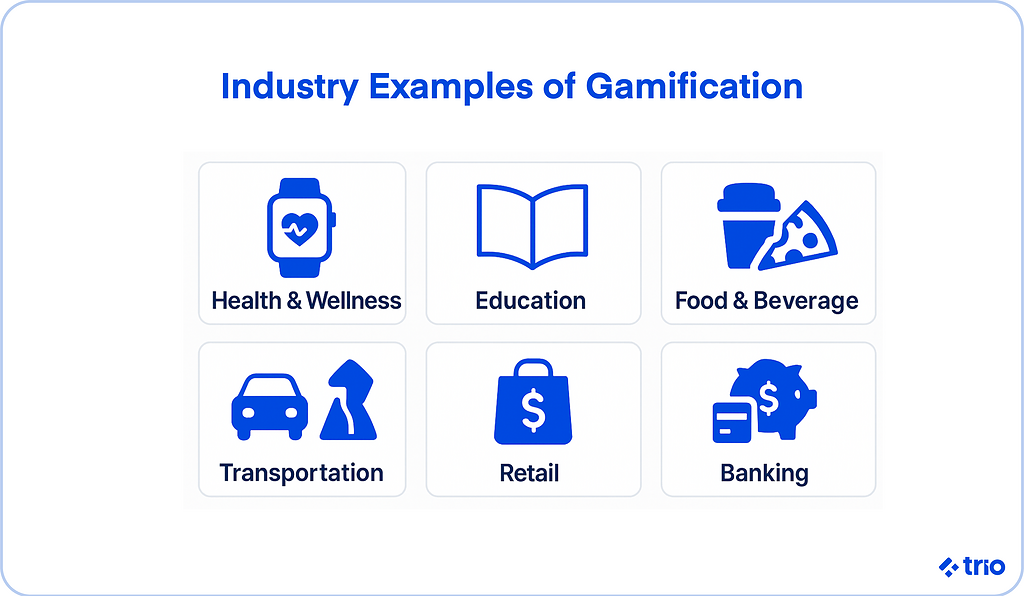
Gamification has been so firmly entrenched in the everyday lives of ordinary people that you might not even notice you’re taking part. The following industries have significantly benefited from incorporating game elements into their applications, resulting in increased revenue growth and enhanced customer retention.
Health & Wellness
Do you receive a nice little badge when you reach your daily fitness goal? Or a star for staying on track with your habits?
These are the simplest examples of gamification in action. To increase engagement and make routine tasks more enjoyable, your applications reward you and encourage you to use them more frequently.
Fitbit and Apple Health both utilize streaks, progress tracking, and achievement badges to encourage users to be more active.
MyFitnessPal builds in daily streaks and social leaderboards, which significantly increase app retention rates.
Education
Education is always a hot topic. Game mechanics, such as collaboration, goals, points, and badges, are widely used in education to create a captivating environment that promotes deeper learning while having fun.
Food & Beverage
Restaurants have a great understanding of what loyalty means to their business. Like Starbucks, restaurants utilize gamification to create engaging programs for customer retention, as well as to enhance the intrigue of dining experiences.
Simple actions, such as placing an order with your phone or using a tablet to play games while waiting for your food, have had a dramatic impact on the industry.
Starbucks Rewards remains the gold standard, with its tiered stars system driving billions in repeat revenue. Domino’s Pizza Hero app gamifies the pizza ordering process by allowing users to “build” pizzas and earn rewards.
Transportation
A popular feature of many taxi and ride-share apps is a real-time tracker that displays a virtual car, enabling users to see exactly where their driver is and when they will arrive. Just like restaurants, transportation companies have also introduced various loyalty programs that encourage customers to use their services more often and receive incentives.
Waze has mastered transportation gamification by rewarding drivers with points for reporting traffic hazards, road conditions, and speed traps.
Retail
Retailers employ various incentives and engagement tactics to connect with their users, increase brand awareness, and boost sales.
From interactive quizzes to incentivized games, loyalty programs, and unforgettable digital experiences, the retail industry probably has the widest variety of successful cases demonstrating how gamification can drive business success.
Nike Run Club utilizes challenges and achievements to connect millions of runners worldwide, transforming fitness into a retail channel for Nike gear. Sephora’s Beauty Insider program utilizes tiered rewards and gamified challenges to encourage customers to return.
Banking
While finances are a serious topic, gamification has been employed by several banks to enhance their customers’ experience. It has been widely used to create personal finance management apps that educate their clients about personal finance and help them understand and manage their cash flow more effectively.
Monobank in Ukraine uses scratch-off cards, challenges, and rewards to make everyday banking fun. BBVA Game in Spain rewarded customers with points for using digital services, redeemable for prizes and discounts.
How To Apply Gamification to the Software Development Process
There are several ways to apply gamification to your software development process. Utilizing gaming features can motivate your development teams to work towards a common goal and keep them engaged throughout the process.
For example, you can take a tip from Cisco and encourage your software developers to learn new skills by tracking their progression and challenging them at each level. This enables developers to adopt a model of continuous learning.
Other organizations have experimented with gamified bug bounties, where developers compete to find and fix errors in exchange for rewards or public recognition. Not only does this sharpen skills, but it also improves software quality simultaneously.
Gamification may also mean fewer errors. You can set up a competition where developers are incentivized to identify as many errors as possible, ultimately improving the software’s performance as a result.
Beyond error reduction, gamification can be woven into everyday workflows. For instance, sprint retrospectives can award badges for collaboration, innovation, or mentorship. Hackathons can be structured like game levels, where advancing teams unlock new challenges and opportunities. These mechanics foster a culture of learning and innovation.
Creating a shared goal is a best practice that every business should implement, regardless of the industry. In a software development team, in addition to completing the project itself, you and your team can discuss goals you want to achieve during the development process and set up metrics to measure them accordingly.
Collaboration is key to the software development process. While competition is excellent, having the same motivations likens software development to a team sport, where everyone must participate.
Assigning badges or shouting out individuals on your team with gifts or rewards helps validate the efforts of those you work with. Even better, these types of incentives do not need to be limited in scope.
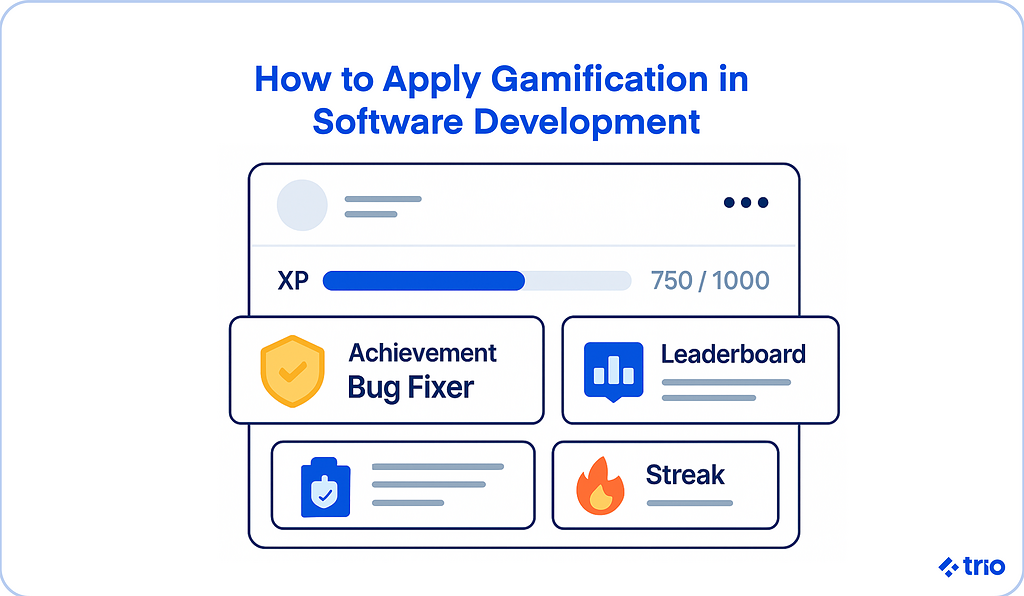
For example, recognition could range from a “fastest bug fix” badge to an award for the “best architectural suggestion.” These gamified acknowledgments align with intrinsic motivators, such as mastery and purpose, keeping developers both challenged and appreciated.
At Trio, we’ve seen firsthand how development teams thrive when gamification is applied thoughtfully. By structuring learning opportunities as challenges and milestones, teams become more productive, more collaborative, and more engaged. This is the true power of gamification in engineering.

Elevate Your Team with Trio AI Talent
Empower Your Projects with Trio’s Elite Tech Teams
How Businesses Can Start With Gamification
Many companies make the mistake of adding points or badges to an app without considering strategy. To avoid wasted effort, follow this step-by-step framework:
1. Define Your Goals
Before choosing game mechanics, decide what you’re trying to achieve. Is it employee training? Customer loyalty? Better product adoption?
Clear goals ensure gamification drives business outcomes, not just entertainment.
2. Choose the Right Mechanics
Not every mechanic works for every purpose.
For example, leaderboards can drive healthy competition in sales teams, while progress bars or streaks are more effective for personal productivity or fitness apps.
3. Start Small With a Pilot
Test gamification with a limited audience first.
This allows you to gather feedback, refine mechanics, and avoid costly missteps.
4. Measure Success With the Right KPIs
Track engagement, retention, or revenue lift depending on your goals.
For employees, that might mean certification rates; for customers, it might mean repeat purchases or app sessions.
5. Iterate and Scale
The best gamification strategies evolve.
Review performance, collect feedback, and refine mechanics on a regular basis. What motivates people today may lose its appeal tomorrow, so iteration is key.
Conclusion
Gamification is more than just getting the latest PlayStation. Even if you’ve never played a video game in your life, if you’ve participated in this economy, you’re likely a gamer. But that isn’t a bad thing. Despite what worried mothers say, practically using games can lead to more interested and invested consumers.
You can use this to your advantage. Whether you run a restaurant, a fitness app, a retail business, or something else entirely, gamification is a viable solution for driving business growth.
Note that a successful project applying gamification typically begins with a team of qualified software developers. Want to know more about the process of hiring remote developers? You’ll find an in-depth resource right here.
Otherwise, you can reach out to get in touch!
FAQs
What is gamification in business?
Gamification in business refers to the application of game mechanics, such as points, badges, and challenges, to enhance engagement and motivation in non-game settings.
How do I start using gamification in my company?
To start using gamification in your company, set clear goals, pick mechanics that fit your audience, run a pilot, and track results.
Which industries benefit most from gamification?
Industries such as education, healthcare, retail, finance, and software development benefit most from gamification, as it improves loyalty and performance.
What are examples of gamification in everyday life?
Examples of gamification in everyday life include Duolingo’s streaks, Fitbit’s badges, Starbucks Rewards stars, and Waze’s driver points.
